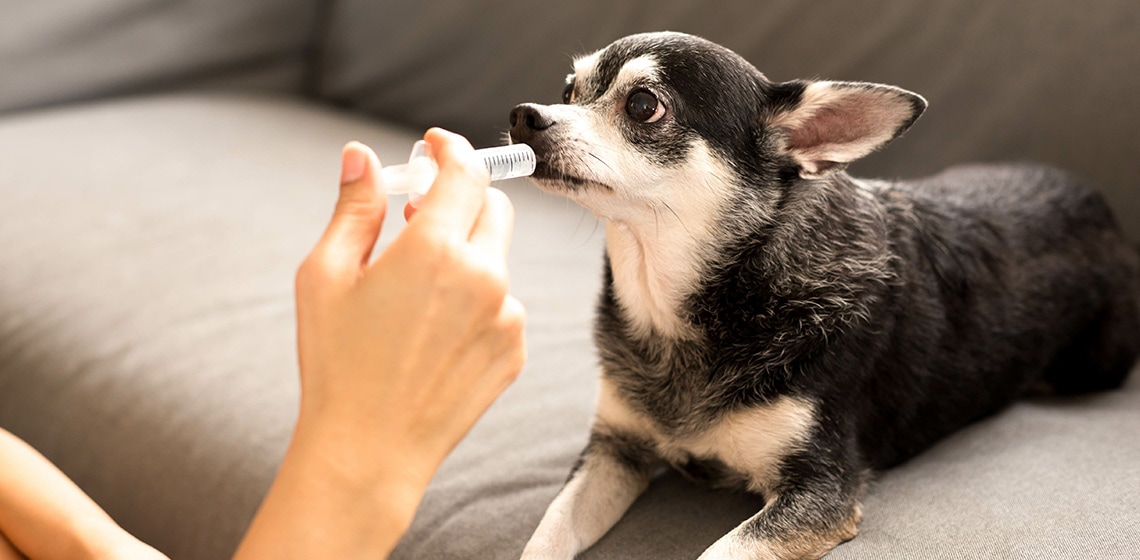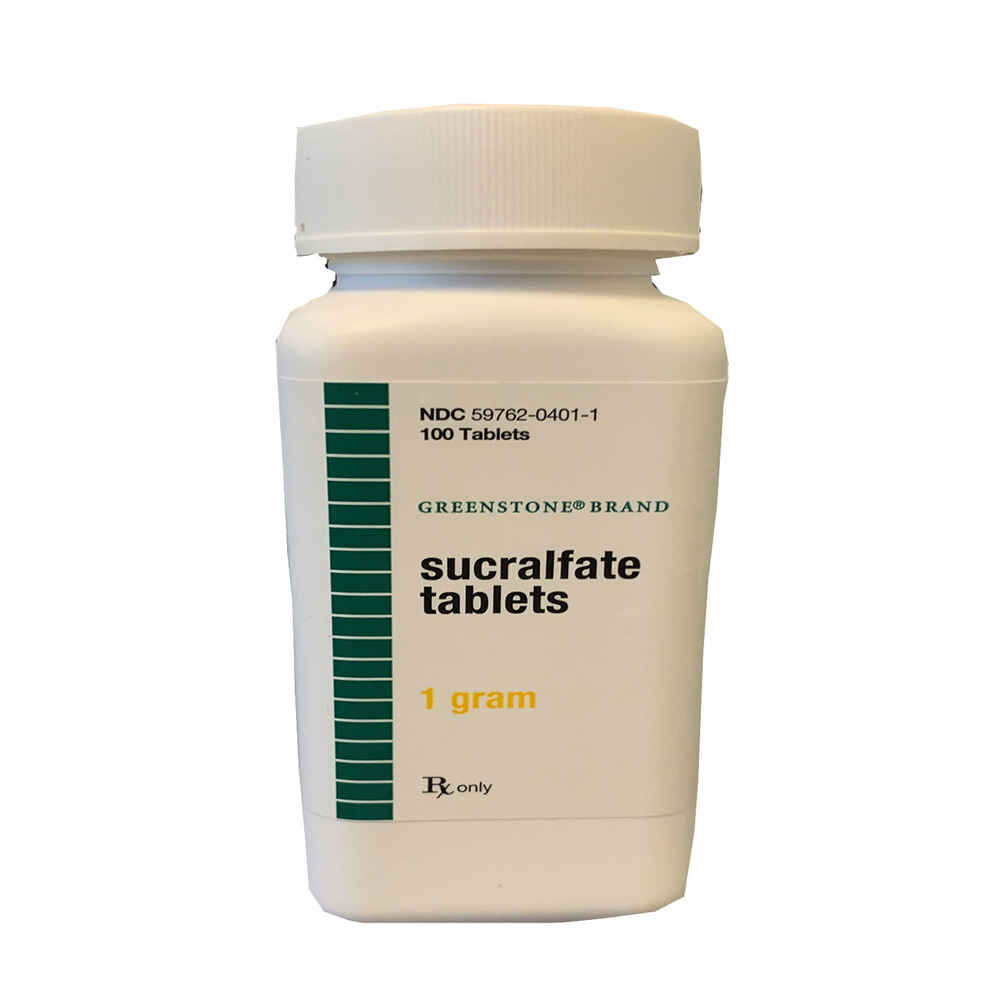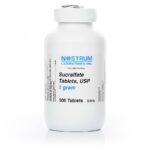Carafate, also known as sucralfate, is a medication used to treat ulcers in dogs. It coats the stomach lining to promote healing.
Table of Contents
Carafate offers significant relief for dogs suffering from gastrointestinal issues. It forms a protective barrier over ulcers, safeguarding the stomach lining from further damage. This medication is particularly effective in treating ulcers caused by acid, bile, and enzymes. Veterinarians often prescribe Carafate to manage conditions like gastritis, esophagitis, and other ulcerative disorders.
Administering this drug can significantly enhance a dog’s quality of life by reducing pain and discomfort. Always consult with a veterinarian for the proper dosage and administration. Carafate is generally well-tolerated but monitoring for any side effects is essential for a dog’s safety.
Introduction To Carafate For Dogs
Carafate is a medication often prescribed for dogs. It helps treat various gastrointestinal issues. Understanding its purpose and use can help you care for your pet better.
What Is Carafate?
Carafate is a brand name for the drug sucralfate. It is commonly used to treat ulcers and other gastrointestinal issues in dogs. The medication works by forming a protective layer over the ulcer. This layer shields the ulcer from stomach acid, allowing it to heal.
Why Use Carafate For Dogs?
There are several reasons why a veterinarian might prescribe Carafate for your dog:
- Ulcer Treatment: Carafate is effective in treating stomach ulcers.
- Gastrointestinal Protection: It forms a barrier against stomach acid.
- Post-Surgery Care: Helps in healing after gastrointestinal surgery.
- Safety: Generally considered safe for long-term use.
Carafate is usually well-tolerated by dogs. Side effects are rare but can include constipation. Always follow your vet’s dosage instructions for the best results.
| Condition | Benefit |
|---|---|
| Ulcers | Heals and protects stomach lining |
| Gastrointestinal Issues | Reduces irritation and promotes healing |
| Post-Surgery | Speeds up recovery |
In summary, Carafate can be a valuable medication for dogs with gastrointestinal issues. Always consult your vet before starting any new treatment.


How Carafate Works
Understanding how Carafate works is important for dog owners. Carafate, also known as Sucralfate, is a medication that helps heal ulcers in dogs. It forms a protective barrier over the ulcer, allowing it to heal. This section will explain the mechanism of action and the benefits for dogs.
Mechanism Of Action
Carafate forms a paste-like substance when it contacts stomach acid. This paste adheres to the ulcer site, creating a protective layer. This layer shields the ulcer from stomach acids and enzymes. As a result, the ulcer can heal without further irritation.
Moreover, Carafate stimulates the production of prostaglandins. Prostaglandins help to increase blood flow to the ulcer site. They also promote the secretion of mucus and bicarbonate, which further protect the ulcer area.
Benefits For Dogs
Carafate offers several benefits for dogs suffering from ulcers:
- Ulcer Healing: It accelerates the healing process of ulcers.
- Pain Relief: By forming a protective layer, it reduces ulcer pain.
- Reduced Irritation: It prevents further irritation from stomach acids.
- Easy to Administer: Carafate is simple to give, usually as a tablet or liquid.
These benefits make Carafate a popular choice for treating ulcers in dogs. It provides a safe and effective way to manage and heal stomach ulcers.
Conditions Treated With Carafate
Carafate is a medication often prescribed for dogs. It helps treat various gastrointestinal issues. This medication protects the stomach lining and helps it heal.
Gastric Ulcers
Gastric ulcers can cause pain and discomfort in dogs. Carafate forms a barrier over the ulcer. This allows the ulcer to heal without further irritation. Dogs with ulcers may show symptoms like vomiting and loss of appetite. Prompt treatment with Carafate can provide relief.
Esophagitis
Esophagitis is the inflammation of the esophagus. This condition can make swallowing painful for dogs. Carafate coats the esophagus, reducing irritation. This helps in soothing the inflamed area. Dogs with esophagitis may drool excessively or refuse food. Carafate aids in the healing process, making it easier for dogs to eat.
Gastrointestinal Inflammation
Gastrointestinal inflammation affects the stomach and intestines of dogs. It can lead to symptoms like diarrhea and abdominal pain. Carafate helps by protecting the GI tract. This allows the inflamed areas to heal faster. Consistent use of Carafate can improve a dog’s digestive health.
| Condition | Symptoms | Carafate’s Role |
|---|---|---|
| Gastric Ulcers | Vomiting, Loss of Appetite | Forms a Protective Barrier |
| Esophagitis | Drooling, Painful Swallowing | Coats and Soothes the Esophagus |
| Gastrointestinal Inflammation | Diarrhea, Abdominal Pain | Protects the GI Tract |
Dosage Guidelines
Understanding the proper dosage of Carafate for dogs ensures effective treatment. It’s crucial to administer the correct amount to avoid any potential side effects. Here we will discuss the recommended dosage and factors that can influence it.
Recommended Dosage
The typical dosage of Carafate for dogs varies based on weight and condition. The standard dosage is usually 0.25 to 1 gram per dog. It’s often given two to four times daily. Always follow the veterinarian’s advice for the most accurate dosage.
| Weight (lbs) | Dosage (grams) | Frequency |
|---|---|---|
| 10-20 | 0.25 – 0.5 | 2-4 times daily |
| 21-40 | 0.5 – 1 | 2-4 times daily |
| 41-60 | 1 | 2-4 times daily |
Administer Carafate on an empty stomach for better absorption. Wait 1 hour before feeding your dog.
Factors Influencing Dosage
Several factors can influence the Carafate dosage for dogs. These include:
- Weight: Heavier dogs may need a higher dose.
- Age: Puppies and seniors might require adjusted doses.
- Health Condition: Severity of the condition affects the dosage.
- Other Medications: Interactions with other drugs can alter dosage needs.
Consult the vet if your dog takes multiple medications. Different conditions may require specific dosage adjustments. Always monitor your dog for any side effects and report them to the vet.
Administration Tips
Administering Carafate to dogs can be straightforward if you follow some simple tips. This section will guide you on the different forms of Carafate and how to administer it effectively to your furry friend.
Forms Of Carafate
Carafate comes in different forms. It is crucial to choose the right form for your dog. The most common forms include:
- Tablets: These are easy to dose and store.
- Liquid Suspension: Suitable for dogs that have trouble swallowing pills.
Each form has its own advantages. Tablets are convenient for larger dogs, while liquid suspension is often better for smaller dogs.
How To Administer
Follow these steps to administer Carafate correctly:
- Measure the Correct Dose: Use a syringe or a measuring spoon for liquid. Use a pill cutter for tablets if needed.
- Empty Stomach: Give Carafate on an empty stomach. Wait at least one hour before feeding your dog.
- Hydration: Ensure your dog drinks water after taking the medicine. This helps the medicine work better.
If you are using tablets, you can crush them and mix with a small amount of water. Administer the mixture using a syringe. For liquid suspension, shake well before use.
| Form | Advantages | Disadvantages |
|---|---|---|
| Tablets | Easy to dose, store | May be hard for some dogs to swallow |
| Liquid Suspension | Good for small dogs, easy to swallow | Needs shaking, may be messy |
Administering Carafate properly ensures your dog gets the full benefit. Always follow your vet’s advice. Keep the tips in mind for a hassle-free experience.


Potential Side Effects
Carafate, also known as sucralfate, helps treat ulcers in dogs. While it is generally safe, it can sometimes cause side effects. Knowing these side effects is important for your dog’s well-being.
Common Side Effects
Most dogs tolerate Carafate well, but some may experience side effects. Below are some common side effects:
- Constipation: This is the most frequent side effect.
- Vomiting: Some dogs may vomit after taking Carafate.
- Diarrhea: Diarrhea can occur in some cases.
- Dry mouth: Your dog might experience dry mouth.
- Gas: Increased gas can sometimes be an issue.
When To Contact A Vet
It is essential to monitor your dog for any unusual signs. Contact your vet if you notice any of the following:
- Severe Constipation: If constipation persists or worsens.
- Persistent Vomiting: Ongoing vomiting can lead to dehydration.
- Severe Diarrhea: Prolonged diarrhea requires immediate attention.
- Allergic Reactions: Symptoms like hives, swelling, or difficulty breathing.
- Behavioral Changes: Unusual lethargy or hyperactivity.
Tracking these side effects and acting promptly can ensure your dog stays healthy. Always consult your vet before starting any new medication.
Interactions With Other Medications
Understanding the interactions of Carafate with other medications is essential. This helps to ensure your dog receives safe and effective treatment.
Drug Interactions
Carafate can interact with other medications. This can affect how well it works. Below are some common interactions:
- Antibiotics: Carafate may reduce the absorption of antibiotics. This means they might not work as well.
- Antacids: Taking antacids too close to Carafate can reduce its effectiveness. Give antacids at least 30 minutes before or after Carafate.
- Thyroid medications: Carafate may interfere with thyroid medication absorption. Monitor thyroid levels regularly.
Precautions
Always inform your vet about other medications your dog takes. This includes prescriptions, over-the-counter drugs, and supplements. Here are some precautions to consider:
- Timing: Separate the timing of Carafate and other medications. This helps to avoid interactions.
- Dosing: Follow the vet’s instructions for dosing. Do not change the dose without consulting the vet.
- Monitoring: Watch for any side effects or unusual behavior in your dog. Report these to your vet immediately.
By understanding these interactions, you can ensure your dog’s safety. Always consult your vet for advice tailored to your dog’s needs.


Frequently Asked Questions
How Long Can A Dog Eat After Carafate?
A dog can eat 1 hour before or 2 hours after taking Carafate. This ensures proper medication absorption.
When Should You Give Your Dog Sucralfate?
Give your dog sucralfate 30 minutes to one hour before meals. Ensure your vet has prescribed the correct dosage.
What Symptoms Does Carafate Treat?
Carafate treats ulcers, gastroesophageal reflux disease (GERD), and irritation in the stomach and intestines. It soothes and protects the digestive lining.
Do You Have To Dissolve Carafate For Dogs?
Yes, you should dissolve Carafate in water before giving it to dogs. This ensures proper absorption and effectiveness.
What Is Carafate Used For In Dogs?
Carafate treats ulcers and gastrointestinal issues in dogs. It coats the stomach lining, promoting healing.
Conclusion
Carafate can effectively treat your dog’s gastrointestinal issues. Always consult your veterinarian before starting any new medication. Proper usage ensures your pet’s health and well-being. By understanding Carafate’s benefits, you can make informed decisions for your dog’s care. Keep your furry friend happy and healthy with the right treatments.


